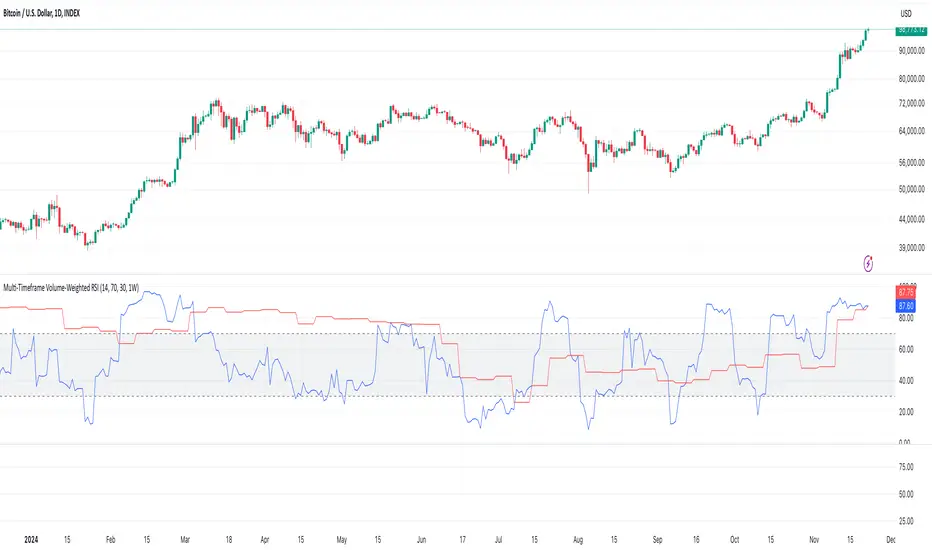OPEN-SOURCE SCRIPT
Multi-Timeframe Volume-Weighted RSI

A multiple timeframe volume-weighted RSI.
Blue Line = Current Time Frame
Orange Line = Select your desired Time Frame
e.g. Blue = Daily, Orange = Weekly
1. Incorporates Market Commitment
Value: By factoring in volume, the volume-weighted RSI captures the intensity of trading activity behind price movements.
Why it’s useful:
Regular RSI measures price momentum but does not differentiate between moves with high or low trading activity.
A volume-weighted RSI assigns greater importance to price changes occurring on high volume, reflecting stronger market conviction.
2. Improved Signal Reliability
Value: Signals generated by a volume-weighted RSI (e.g., overbought or oversold conditions) may be more reliable because they account for the level of trader participation.
Why it’s useful:
Low-volume price movements often result in false signals or "noise."
A volume-weighted RSI helps filter out such noise, reducing the likelihood of false breakouts or fake reversals.
3. Better Divergence Detection
Value: Divergences between price action and the RSI (bullish or bearish divergences) are more meaningful when confirmed by volume.
Why it’s useful:
Regular RSI might show divergence in price momentum, but this divergence might lack substance if the underlying volume is weak.
A volume-weighted RSI ensures that divergence signals align with periods of significant market participation.
4. Enhanced Trend Analysis
Value: Trends supported by strong volume are given more weight, helping traders better identify and follow trends.
Why it’s useful:
Regular RSI might show overbought or oversold signals prematurely during strong trends.
Volume-weighted RSI considers whether trends are backed by significant market activity, helping avoid early exits.
5. More Meaningful Overbought/Oversold Levels
Value: Levels like 70 (overbought) and 30 (oversold) are more credible when supported by volume.
Why it’s useful:
In a regular RSI, overbought or oversold levels might occur on light trading, leading to false reversals.
A volume-weighted RSI ensures these levels are triggered by substantial market participation, increasing their reliability.
Practical Applications:
Trend Confirmation: Use the volume-weighted RSI to confirm whether momentum in a trend is supported by strong participation.
Divergence Spotting: Identify divergences with more confidence by prioritizing those with volume support.
Filtering False Breakouts: Avoid entering trades during weak volume phases by focusing on volume-weighted RSI signals.
Limitations:
Market Type Dependency: Its usefulness may diminish in low-volume assets or markets where volume data is unavailable (e.g., forex).
Blue Line = Current Time Frame
Orange Line = Select your desired Time Frame
e.g. Blue = Daily, Orange = Weekly
1. Incorporates Market Commitment
Value: By factoring in volume, the volume-weighted RSI captures the intensity of trading activity behind price movements.
Why it’s useful:
Regular RSI measures price momentum but does not differentiate between moves with high or low trading activity.
A volume-weighted RSI assigns greater importance to price changes occurring on high volume, reflecting stronger market conviction.
2. Improved Signal Reliability
Value: Signals generated by a volume-weighted RSI (e.g., overbought or oversold conditions) may be more reliable because they account for the level of trader participation.
Why it’s useful:
Low-volume price movements often result in false signals or "noise."
A volume-weighted RSI helps filter out such noise, reducing the likelihood of false breakouts or fake reversals.
3. Better Divergence Detection
Value: Divergences between price action and the RSI (bullish or bearish divergences) are more meaningful when confirmed by volume.
Why it’s useful:
Regular RSI might show divergence in price momentum, but this divergence might lack substance if the underlying volume is weak.
A volume-weighted RSI ensures that divergence signals align with periods of significant market participation.
4. Enhanced Trend Analysis
Value: Trends supported by strong volume are given more weight, helping traders better identify and follow trends.
Why it’s useful:
Regular RSI might show overbought or oversold signals prematurely during strong trends.
Volume-weighted RSI considers whether trends are backed by significant market activity, helping avoid early exits.
5. More Meaningful Overbought/Oversold Levels
Value: Levels like 70 (overbought) and 30 (oversold) are more credible when supported by volume.
Why it’s useful:
In a regular RSI, overbought or oversold levels might occur on light trading, leading to false reversals.
A volume-weighted RSI ensures these levels are triggered by substantial market participation, increasing their reliability.
Practical Applications:
Trend Confirmation: Use the volume-weighted RSI to confirm whether momentum in a trend is supported by strong participation.
Divergence Spotting: Identify divergences with more confidence by prioritizing those with volume support.
Filtering False Breakouts: Avoid entering trades during weak volume phases by focusing on volume-weighted RSI signals.
Limitations:
Market Type Dependency: Its usefulness may diminish in low-volume assets or markets where volume data is unavailable (e.g., forex).
Open-source script
In true TradingView spirit, the creator of this script has made it open-source, so that traders can review and verify its functionality. Kudos to the author! While you can use it for free, remember that republishing the code is subject to our House Rules.
Disclaimer
The information and publications are not meant to be, and do not constitute, financial, investment, trading, or other types of advice or recommendations supplied or endorsed by TradingView. Read more in the Terms of Use.
Open-source script
In true TradingView spirit, the creator of this script has made it open-source, so that traders can review and verify its functionality. Kudos to the author! While you can use it for free, remember that republishing the code is subject to our House Rules.
Disclaimer
The information and publications are not meant to be, and do not constitute, financial, investment, trading, or other types of advice or recommendations supplied or endorsed by TradingView. Read more in the Terms of Use.